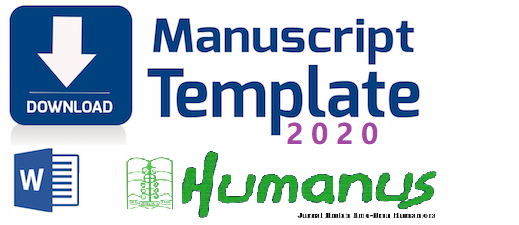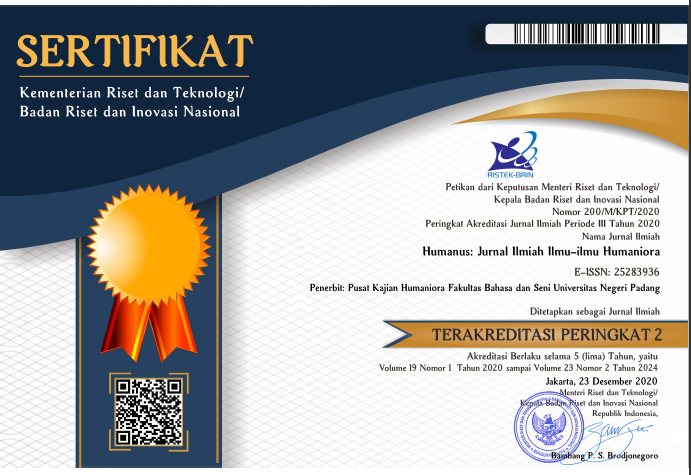The Impact of Translation Techniques on the Accuracy of the Translation of Commissive Speech Acts’ Responses in Dark Matter Novel
 ), Mangatur Nababan(2), Djatmika .(3),
), Mangatur Nababan(2), Djatmika .(3), (1) Universitas Sebelas Maret
(2) Universitas Sebelas Maret
(3) Universitas Sebelas Maret
 Corresponding Author
Corresponding Author
Copyright (c) 2020 Humanus
DOI : https://doi.org/10.24036/humanus.v19i1.102684
Full Text:
 Language : en
Language : en
Abstract
Keywords
References
Ad-Darraji, H. H., Chow Voon Foo, T., Ismail, S. A. M., & Shaker Abdulah, E. (2012). Offering as a comissive and directive speech act: Consequence for cross-cultural communication. International Journal of Scientific and Research Publications, 2(3), 1–6.
Akmal, A. (2017). The equivalences translation of the commissive utterances in Serdadu Kumbang by Rain Chudori Sorjoatmodjo an English-Indonesian Novel. UIN.
Al-Bantany, N. F. (2013). The Use of Commissive Speech Acts and Its Politeness Implication: A Case of Banten Gubernatorial Candidate Debate. Passage, 1(Vol 1, No 2 (2013): October Graduation 2013), 21–34. Retrieved from http://ejournal.upi.edu/index.php/psg/article/view/534
Aloojaha, A., & Nababan, M. R. (2018). the Impact of Translation Techniques on Shifting Meaning, 12(August), 279–287. https://doi.org/10.21512/lc.v12i3.4301
Dylgjeri, A. (2017). Analysis of Speech Acts in Political Speeches. European Journal of Social Sciences Studies, 2(2), 19–26. https://doi.org/10.5281/zenodo.344518
Emzir. (2015). Teori dan Pengajaran Penerjemahan.
Fitriana, I. (2014). Analisis Teks dan Kualitas Terjemahan Tindak Tutur Ekspresif dalan Novel Stealing Home (Hati yang Terenggut) karya Sherryl Wood. Universitas Sebelas Maret: Surakarta.
House, J. (2015). Translation quality assessment past and present (first). London, New York: Routledge.
Larson, M. L. (1984). Meaning Based Translation A Guide to Cross-Language Equivalence. London, New York: University Press of America.
Liestyorini, I., & Nurhayati. (2017). Commissive Speech Act in the First Debate of Jakarta Governor Election 2017. Journal on English Language, Culture and Literature, 6(3), 1–12.
Macali, R. (2000). Pedoman Bagi Penerjemah. Jakarta: Gramedia.
McKay, S. L., & Hornberger, N. H. (1995). Sociolinguistics and Language Teaching (Cambridge Applied Linguistics). Cambridge: Cambridge University Press. https://doi.org/10.1017/CBO9780511551185
Molina, L., & Hurtado, A. (2002). Translation Techniques Revisited : A Dynamic and Functionalist Approach, 498–512.
Nababan, M., Nuraeni, A., & Sumardiono. (2012). Pengembangan Model Penilaian Kualitas Terjemahan, 24(1), 39–57.
Nababan, M. R. (2003). Teori Menerjemah Bahasa Inggris. Pustaka Pelajar.
Nida, Eugene .A & Taber, C. R. (1982). The Theory and Practice in Translation. Leiden: E.J Brill.
Nourzad, L., & Jabbari, M. J. (2015). A Cross-Linguistic Analysis of English-Persian Commissives and Directives in Of Mice and Men. International Journal of English and Education, 4(1), 61–73.
Puspitasari, K. D. (2009). An analysis of commissive speech acts employed by the characters in the movie “a bug’s life” (a pragmatics study). UNS.
Rashid, B. N. ’ ma. (2015). A Pragmatic Analysis of Commissive in Some Selected American Political Texts. International Journal of Current Research, 7(12), 23805–23814.
Salgueiro, A. B. (2010). Promises, threats, and the foundations of Speech Act Theory. Pragmatics, 20(2), 213–228. https://doi.org/10.1075/prag.20.2.05bla
Searle, J. R. (1969). Speech Acts An Essay in the Philosophy of Language. Cambridge: Cambridge University Press.
Shuttleworth, M., & Cowie, M. (1997). Dictionary to Translation Study (1st ed.). Manchester: St. Jerome Publishing.
Vanderveken, D. (1990). Meaning and Speech Acts: Volume 1, Principles of Language Use (first). New York: Cambridge University Press.
Yafi, M. A., & Haryanti, D. (2009). Speech Acts in Novel Translation ; are They Pragmatically Accurate ? In Asosiasi Program Pascasarjana Perguruan Tinggi Muhammadiyah (pp. 20–27). Surakarta.
Yule, G. (1996). Pragmatics (first). New York: Oxford University Press.
 Article Metrics
Article Metrics
 Abstract Views : 705 times
Abstract Views : 705 times
 PDF Downloaded : 321 times
PDF Downloaded : 321 times
Refbacks
- There are currently no refbacks.
Copyright (c) 2020 Humanus

This work is licensed under a Creative Commons Attribution-NonCommercial 4.0 International License.










